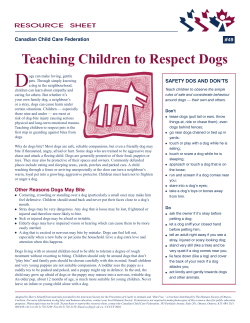
Treatming Common Insect Bites
Pawsitive Experience 1289 NW Promontory Dr. Bend, OR 97701 541-318-8459 trainingdogs123@bendbroadband.com www.PawsitiveExperience.com Treatming Common Insect Bites The summer months are the time when we see more insect bites. The most common bites come from bees, wasps, yellow jackets, and hornets because our dogs got too close to a nest or because they tested to see if these flying insects are tasty to eat. Bee Stings The symptoms of a bee-type sting will be local swelling, and your dog pawing or rubbing the area of the sting. Most dogs are stung on the face so you will see swelling of the face and muzzle area. For routine treatment you can apply ice to the sting to reduce the pain and swelling, and give an over the counter antihistamine like Benedryl to reduce the inflammation, and repeat every 6-8 hours. Check with your veterinarian ahead of time to know the exact dose for your dog’s weight. A poultice of baking soda can help neutralize the sting, but can be messy. Many outdoor shops carry a sting neutralizer such as StingEze which is pre-mixed and easier to apply. It can become dangerous if your dog has been stung multiple times, has swallowed the bee, has been stung inside the mouth or throat, or if your dog is allergic and has absorbed too much of the toxin. In these cases, your dog could go into shock. This can be deadly and a vet emergency. Your dog can go into anaphylactic shock within 10-20 minutes of being stung. If your dog has any symptoms such as excessive swelling of the face and tongue, or pale gums and labored breathing, it is important to rush your dog to a vet. Spider Bites Spider bites are not dangerous unless your dog encounters a black widow, hobo, or brown recluse. Since these spiders are shy by nature, it is a rare encounter, but dogs that have been bitten by these venomous spiders will be experiencing a lot of pain, develop chills and a fever, and labored breathing. If you dog show these symptoms it is important to get them to a vet immediately. Average spider bites can be left alone or ice can be applied to relieve pain. Look for any secondary infections. Ticks We don’t have many ticks around here in Central Oregon, but if you travel with your dog to western Oregon or other states, be aware of tick-borne diseases. Lyme, Ehrlichiosis, and Rocky Mountain Spotted Fever are the three most common tick-borne diseases. If you’re hiking with your dog in tick country, check with your vet to learn the symptoms of these tick borne diseases, which vary widely. It is important to remove a tick within 12 hours of a bite to prevent transmission of the disease from the tick’s saliva to your dog’s blood stream. If you do find a tick on your dog, use surgical gloves to remove the tick to prevent the tick from transmitting the disease into an open cut or sore you may have on your hands. Take blunt end tweezers as close to the skin as possible and gently pull straight back to remove. Sometimes just the body part will come out and not the head. The skin will slough off the head eventually. After removing the tick, disinfect the area with 3% hydrogen peroxide or an antiseptic soap to prevent infection. Watch over the next 14 days for any illness that may occur in your dog. Look for fever, lethargy, depression, lameness, bleeding from the nose, blood in urine or feces, unusual swelling, or paralysis. Stay safe out there and enjoy the summer with your dogs. Meredith Gage Pawsitive Experience 541-318-8459 Trainingdogs123@bendbroadband.com www.PawsitiveExperience.com
© Copyright 2025





















